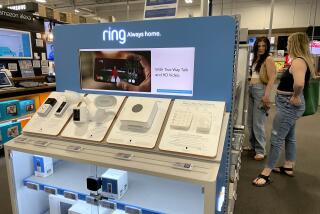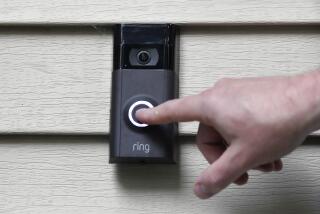Why Picturephones Are a Bad Call
- Share via
When the country’s phone systems aren’t too busy crashing, futurists love to paint rosy scenarios of network nirvanas: fiber optic superhighways of the Information Age that can transmit the entire contents of the Library of Congress faster than you can dial 411.
The rise of digital switches, data compression techniques and solid-state cameras, they say, will soon make sending your image over phone lines as cheap and easy as sending your voice. Videophones will become as ubiquitous tomorrow as personal computers and fax machines today. You’ll finally be able to reach out and touch someone with your winsome smile as well as your gentle hello . Forget that daily drive to the office--you’ll be “video-telecommuting” from home.
I won’t quibble about the technology, but this vision of high-bandwidth bonding is a sucker’s bet. Speaking as a hard-core phone-aholic, the only thing worse than having to look at the person I’m talking with is to have them looking at me. I want the visual anonymity that telephones confer. I don’t want a conversation where appearances matter. Unlike children, telephones should be heard and not seen.
Let’s be honest. There’s a very good reason why I don’t want you looking at me while we’re talking on the phone. Why? Because I’m doing other things. I’m writing letters; I’m reading the newspaper; I’m scanning my electronic mail; I’m nibbling a fingernail--in short, I’m not giving you my undivided attention. I’m sorry.
And do you know what? I have the sneaking suspicion that most of the people I talk with are also doing other things. Does this offend me? Absolutely not. I find it liberating. The telephone is a medium that lets us meaningfully converse without shackling us to the protocols of eye contact and body language.
In the real world--where people are busy and time is short--video and telephones are about as compatible as blackboards and fingernails. The videophone is less a hardy technological hybrid than an annoyingly intrusive mutant. Hey, I like dogs and I like tropical fish--but that doesn’t mean I want a puppy with gills as my pet.
Literally 20 years ago, the old Bell System formally introduced its Picturephone service. To quote Bell Labs scientist Robert Lucky: “It was predicted that the market would start slowly, and then take off. This prediction turned out to be half right.”
At the time, experts blamed the high equipment and transmission costs for Picturephone’s abysmal failure. I don’t doubt for a second that technological advances will put the cost of a next-generation videophone within our grasp. But is that what most of us really want?
Remember how we used to use voice mail and answering machines primarily to record our calls? Now how many of us use those technologies to screen our calls as well? The fact is, we are at least as interested in using technology to preserve our privacy and our time as to maximize our interactions and intimacies.
The videophone concept--direct face-to-face interaction--may be both technically and economically feasible, but it is still a lousy idea. It failed two decades ago, and it deserves to fail again because it doesn’t respect how people really want to interact.
“I still love the idea of Picturephone,” says Robert E. LaBlanc, a telecommunications consultant who worked on the original Bell Systems Picturephone team. “But it wouldn’t work today.”
The videophone is simply the wrong way to sculpt and mold all the bandwidth capacity that’s emerging in telecommunications. “You need to use the technology to make people part of the background rather than the focus,” asserts Marilyn Mantei, a University of Toronto professor who is building bandwidth-based open office systems. “You don’t want the technology to make people more intimate than they want to be.”
What Mantei and other researchers are discovering is that it makes more sense to create “common rooms” and “virtual hallways” where people can choose to enter and interact rather than train a camera at them on their desks. How best to design these telespaces isn’t just the focus of academic research. Companies ranging from Xerox to Steelcase to Bellcore are creating these high-bandwidth office domains.
“That’s the real future of the videophone,” Mantei says. “You’ll have a channel switcher--just like a television remote control--and you’ll be able to click and scan your environment. I can imagine an office of the future with video on one wall, and you can click and scan the conference room or click and see what’s going on outside the boss’s office.” Or click and see what’s going on at a meeting a continent away.
Ironically, it seems that the best model for the video environment is Alexander Graham Bell’s telephone: To work, visual interactions not only need to stress the informal over the formal, they--surprise!--have to preserve one’s ability to do other things at the same time. People have to be able to browse--not just stare. In essence, the technology has to treat people as people really are--not as biological high-bandwidth input devices hooked into high-speed digital networks.
But then, I suppose the habit of technology firms repeating their past mistakes is pretty human too.






